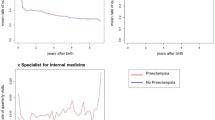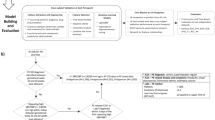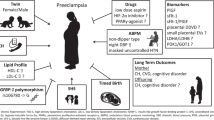Abstract
Preeclampsia is a leading complication of pregnancy that lacks accurate tools for its early prediction. Improved risk stratification tools early in pregnancy would enable more efficient allocation of limited healthcare resources while ensuring that pregnant women destined to develop preeclampsia receive appropriate care. This brief perspective highlights the current state of first-trimester preeclampsia prediction. We focus on arterial stiffness, an important hemodynamic indicator of vascular health that has shown promising results for improved early prediction of preeclampsia by our and independent research groups. Further, we outline the promise, applicability, and feasibility of integrating arterial stiffness assessments into clinical practice.

This is a preview of subscription content, access via your institution
Access options
Subscribe to this journal
Receive 12 digital issues and online access to articles
$119.00 per year
only $9.92 per issue
Buy this article
- Purchase on SpringerLink
- Instant access to full article PDF
Prices may be subject to local taxes which are calculated during checkout
Similar content being viewed by others

References
Magee LA, Nicolaides KH, von Dadelszen P. Preeclampsia. N Engl J Med. 2022;386:1817–32.
Phan K, Gomez YH, Gorgui J, El-Messidi A, Gagnon R, Abenhaim HA, et al. Arterial stiffness for the early prediction of pre-eclampsia compared with blood pressure, uterine artery Doppler and angiogenic biomarkers: a prospective cohort study. BJOG: Int J Obstet Gynaecol. 2023;130:932–40.
Phan K, Schiller I, Dendukuri N, Gomez Y-H, Gorgui J, El-Messidi A, et al. A longitudinal analysis of arterial stiffness and wave reflection in preeclampsia: Identification of changepoints. Metabolism. 2021;120:154794.
Magee LA, Smith GN, Bloch C, Côté A-M, Jain V, Nerenberg K, et al. Guideline No. 426: hypertensive disorders of pregnancy: diagnosis, prediction, prevention, and management. J Obstet Gynaecol Can. 2022;44:547–71.e1.
Gestational Hypertension and Preeclampsia: ACOG Practice Bulletin, Number 222. Obstetrics & Gynecology. 2020;135:e237–e260.
Poon LC, Shennan A, Hyett JA, Kapur A, Hadar E, Divakar H, et al. The International Federation of Gynecology and Obstetrics (FIGO) initiative on pre-eclampsia: A pragmatic guide for first-trimester screening and prevention. Int J Gynaecol Obstet. 2019;145(Suppl 1):1–33. Erratum in: Int J Gynaecol Obstet. 2019;146:390–391.
MacDonald TM, Walker SP, Hannan NJ, Tong S, Tu’uhevaha J. Clinical tools and biomarkers to predict preeclampsia. EBioMedicine. 2022;75.
Cnossen JS, Vollebregt KC, de Vrieze N, ter Riet G, Mol BW, Franx A, et al. Accuracy of mean arterial pressure and blood pressure measurements in predicting pre-eclampsia: systematic review and meta-analysis. BMJ. 2008;336:1117–20.
Tian Y, Yang X. A review of roles of uterine artery doppler in pregnancy complications. Front Med (Lausanne). 2022;9:813343.
Matevosyan NR. Predictive accuracy of the first trimester Doppler scan: a meta-study. Wien Med Wochenschr. 2015;165:199–209.
Tan M, Wright D, Syngelaki A, Akolekar R, Cicero S, Janga D, et al. Comparison of diagnostic accuracy of early screening for pre‐eclampsia by NICE guidelines and a method combining maternal factors and biomarkers: results of SPREE. Ultrasound Obstet Gynecol. 2018;51:743–50.
Basaran OE, Guven ESG, Guven S. First trimester fetal thymus volume may predict preeclampsia. Pregnancy Hypertens. 2021;26:116–20.
Nuckols VR, Holwerda SW, Luehrs RE, DuBose LE, Stroud AK, Brandt D, et al. Beat-to-beat blood pressure variability in the first trimester is associated with the development of preeclampsia in a prospective cohort: relation with aortic stiffness. Hypertension. 2020;76:1800–7.
Garg P, Jaryal AK, Kachhawa G, Kriplani A, Deepak KK. Sequential profile of endothelial functions and arterial stiffness in preeclampsia during the course of pregnancy. Pregnancy Hypertens. 2019;18:88–95.
Velauthar L, Plana M, Kalidindi M, Zamora J, Thilaganathan B, Illanes S, et al. First‐trimester uterine artery Doppler and adverse pregnancy outcome: a meta‐analysis involving 55974 women. Ultrasound Obstet Gynecol. 2014;43:500–7.
Kenny LC, Black MA, Poston L, Taylor R, Myers JE, Baker PN, et al. Early pregnancy prediction of preeclampsia in nulliparous women, combining clinical risk and biomarkers: the Screening for Pregnancy Endpoints (SCOPE) international cohort study. Hypertension. 2014;64:644–52.
O’Gorman N, Wright D, Poon L, Rolnik DL, Syngelaki A, de Alvardo M, et al. Multicenter screening for pre‐eclampsia by maternal factors and biomarkers at 11–13 weeks’ gestation: comparison with NICE guidelines and ACOG recommendations. Ultrasound Obstet Gynecol. 2017;49:756–60.
Sokratous N, Bednorz M, Sarli P, Morillo Montes O, Syngelaki A, Wright A, et al. Screening for pre‐eclampsia by maternal serum glycosylated fibronectin at 11− 13 weeks’ gestation. Ultrasound Obstet Gynecol. 2023;62:504–11.
Kaufmann P, Mayhew T, Charnock-Jones D. Aspects of human fetoplacental vasculogenesis and angiogenesis. II. Changes during normal pregnancy. Placenta. 2004;25:114–26.
Burton GJ, Jauniaux E. Placental oxidative stress: from miscarriage to preeclampsia. J Soc Gynecologic Investig. 2004;11:342–52.
Chirinos JA, Segers P, Hughes T, Townsend R. Large-artery stiffness in health and disease: JACC state-of-the-art review. J Am Coll Cardiol. 2019;74:1237–63.
Nilsson PM, Boutouyrie P, Laurent S. Vascular aging: a tale of EVA and ADAM in cardiovascular risk assessment and prevention. Hypertension. 2009;54:3–10.
Murray EC, Delles C, Orzechowski P, Renc P, Sitek A, Wagenaar J, et al. Vascular phenotypes in early hypertension. J Hum Hypertens. 2023;37:898–906.
Mancia G, Kreutz R, Brunström M, Burnier M, Grassi G, Januszewicz A, et al. 2023 ESH Guidelines for the management of arterial hypertension The Task Force for the management of arterial hypertension of the European Society of Hypertension: Endorsed by the International Society of Hypertension (ISH) and the European Renal Association (ERA). J Hypertens. 2023; 41:1874–2071.
Ben-Shlomo Y, Spears M, Boustred C, May M, Anderson SG, Benjamin EJ, et al. Aortic pulse wave velocity improves cardiovascular event prediction: an individual participant meta-analysis of prospective observational data from 17,635 subjects. J Am Coll Cardiol. 2014;63:636–46.
Salvi P. Pulse waves: How vascular hemodynamics affects blood pressure. 2nd ed. Springer Nature, 2017.
Heusinkveld MH, Delhaas T, Lumens J, Huberts W, Spronck B, Hughes AD, et al. Augmentation index is not a proxy for wave reflection magnitude: mechanistic analysis using a computational model. J Appl Physiol. 2019;127:491–500.
Daskalopoulou SS. Chapter 42 - Arterial stiffness and pulsatile hemodynamics in pregnancy and pregnancy-related vascular complications. In: Chirinos JA, editor. Textbook of Arterial Stiffness and Pulsatile Hemodynamics in Health and Disease: Academic Press; 2022. p. 665-87.
Fraser A, Catov JM. Placental syndromes and long-term risk of hypertension. J Hum Hypertens. 2023;37:671–4.
Kuate Defo A, Daskalopoulou SS. Alterations in vessel hemodynamics across uncomplicated pregnancy. Am J Hypertens. 2023;36:183–91.
Garrido-Gomez T, Castillo-Marco N, Cordero T, Simon C. Decidualization resistance in the origin of preeclampsia. Am J Obstet Gynecol. 2022;226:S886–S94.
Almaani SJ. Placental growth factor in pre-eclampsia: friend or foe? Kidney Int. 2019;95:730–2.
Williams D. Pregnancy: a stress test for life. Curr Opin Obstet Gynecol. 2003;15:465–71.
Vyas M, Izzo JL Jr, Lacourciere Y, Arnold JM, Dunlap ME, Amato JL, et al. Augmentation index and central aortic stiffness in middle-aged to elderly individuals. Am J Hypertens. 2007;20:642–7.
Funding
The PULSE Study is funded by the Canadian Institutes of Health Research (PJT-168918). MF is supported by a FRQS Doctoral Training Award.
Author information
Authors and Affiliations
Contributions
MF, MM, BVS, HPQ, and SSD contributed to the conceptualization of the manuscript and outline of presented ideas. MF, MM, and BVS performed the literature review. MF drafted the manuscript, MM designed Table 1, and BVS designed the graphical abstract. BS and JS contributed scientific input and clinical review throughout the drafting process. All authors critically reviewed and approved the final version of the manuscript.
Corresponding author
Ethics declarations
Competing interests
The authors declare no competing interests.
Additional information
Publisher’s note Springer Nature remains neutral with regard to jurisdictional claims in published maps and institutional affiliations.
Rights and permissions
Springer Nature or its licensor (e.g. a society or other partner) holds exclusive rights to this article under a publishing agreement with the author(s) or other rightsholder(s); author self-archiving of the accepted manuscript version of this article is solely governed by the terms of such publishing agreement and applicable law.
About this article
Cite this article
Forrest, M., Matossian, M., Valdes Sustaita, B. et al. Arterial stiffness as a novel tool for the early prediction of preeclampsia: a perspective. J Hum Hypertens 38, 745–749 (2024). https://doi.org/10.1038/s41371-024-00967-6
Received:
Revised:
Accepted:
Published:
Issue date:
DOI: https://doi.org/10.1038/s41371-024-00967-6


